Freshwater angelfish are some of the most beautiful and visually striking freshwater fish in the world, making them a popular choice for aquariums. Although angelfish might capture your heart with their breathtaking colors and graceful movements, it’s important not to rush into the decision to bring an angelfish into your home.

A lot goes into creating the ideal environment for a freshwater angelfish (who's scientific name is Pterophyllum) from species and tank measurements to plant materials and centerpieces. You’ll also need to consider the typical angelfish diet, potential health risks, and compatible tank mates. In this guide on rare freshwater angelfish, and how to care for them we will be explaining how to set up your aquarium to give your angelfish the best possible life.
Different Species of Freshwater Angelfish
The first thing to bear in mind if you’re considering bringing home one or several rare freshwater angelfish is that there are several different species of freshwater angelfish, all with their own unique traits.
1. Silver Angelfish
The silver angelfish is likely to be your top choice if you’re looking for a fish that looks like the common angelfish. Silver angelfish are also the best choice for beginners in the world of angelfish care because they are very robust, so they’re quite low-maintenance.

You’ll be able to recognize the silver angelfish from its distinctive silver coloring and three stripes. The coloring might change according to the fish’s mood, so this makes it quite easy to tell whether your fish is healthy and happy.
The main thing to watch out for if you bring home a silver angelfish is that these fish have a tendency to overeat, especially when it comes to mosquito larvae. This can be detrimental to their health, so make sure to keep these treats to a minimum.
2. Black Lace Angelfish
Most people select angelfish as centerpieces for their aquariums because of their striking colors. However, if you’re looking for an angelfish that will lend a touch of mysterious darkness to your aquarium, you might prefer a Black Lace Angelfish.

This majestic-looking angelfish was created through breeding between darkly-colored silver and zebra angelfish (see below). If you choose a black lace angelfish, make sure you have an extra-large aquarium, as this angelfish variant can grow up to 14 inches (35 cm) in length.
You’ll also need to ensure that your home is a relatively peaceful environment because although black lace angelfish are quite passive, they can be easily startled.
3. Koi Angelfish
Koi angelfish have the same bright coloring as koi goldfish. Their scales are gold, yellow, and orange, although younger koi angelfish have red spots underneath their eyes that disappear with age.
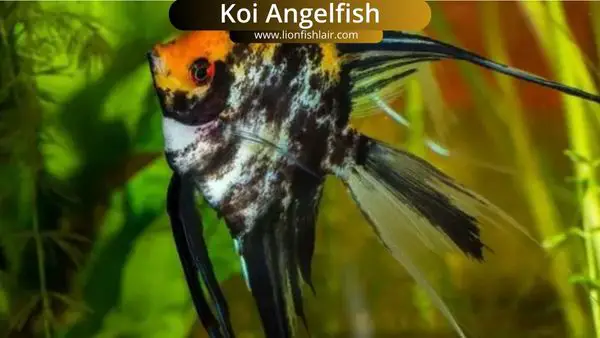
If you’re worried about being able to discern your angelfish’s mood, the koi angelfish is an excellent choice because its coloring actually gets darker when it experiences stress.
4. Marble Angelfish
Marble angelfish are probably the most unique angelfish variant, and also one of the healthiest, so they provide the perfect combination of entrancing colors and easy maintenance.
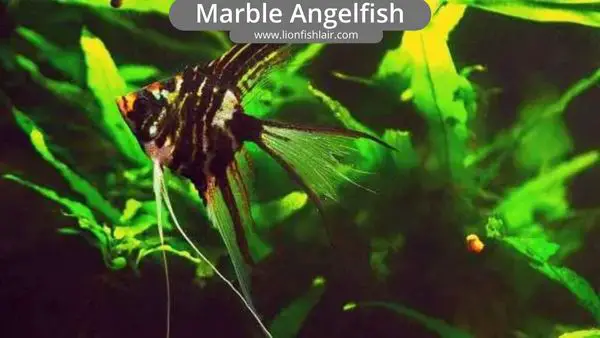
These angelfish are also a good option if you want to keep your angelfish with other species since their fins are on the shorter side, meaning they won’t be a target for other curious or hungry fish.
Plus, marble angelfish are the most common freshwater angelfish variant sold in pet stores, so they’re easy to find.
5. Gold Angelfish
Gold angelfish actually have a mix of silver and gold in their scales, although the gold usually only comes through once the fish reaches maturity.
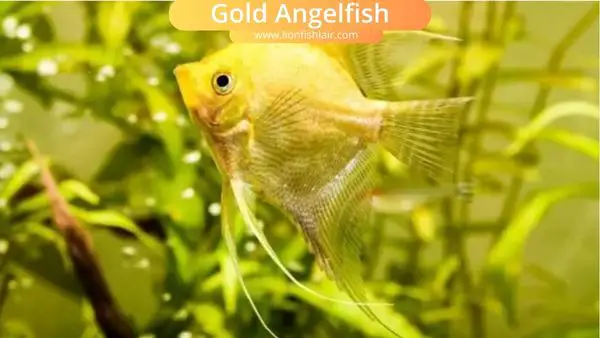
While these angelfish look absolutely stunning, especially in the right lighting conditions, you’ll need to carefully consider which fish to house your gold angelfish with. Their fins are longer than average, which may be tempting for bolder and more inquisitive fish.
6. Albino Angelfish
The albino angelfish is a very special type of freshwater angelfish. Usually, these fish are white all over with very light gold stripes and pink eyes.

Although albino angelfish are unique and beautiful, we wouldn’t necessarily recommend them to first-time fish owners because they are quite susceptible to disease and need a lot of care and attention to stay healthy.
Even then, these angelfish don’t live very long lives, which can be difficult for everyone involved if attachments are formed.
7. Zebra Angelfish
Zebra angelfish make eye-catching additions to freshwater aquariums because of their bold, distinctive striped pattern. Even though zebra angelfish are typically smaller than most other freshwater angelfish species, they are some of the most active, so they need a lot of space to move around.

If you do choose to bring home a zebra angelfish, make sure you select their companions carefully since their smaller size can make them targets for aggression and intimidation.
8. Leopard Angelfish
Leopard angelfish are related to the common angelfish, but they look different in the sense that they have spotted scales instead of stripes. These aren’t necessarily the most beginner-friendly angelfish out there because they need very specific (natural) lighting conditions in order to keep their spots from fading.
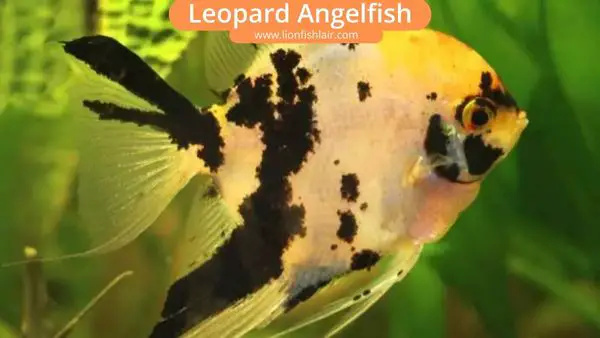
However, the plus side is that leopard angelfish are one of the healthier angelfish variants, so as long as you feel you’ll be able to manage the tank lighting properly, there shouldn’t be too much extra maintenance.
9. Veil Angelfish
Veil angelfish have some of the most impressive fins in the entire angelfish family. These fins are long and delicate, trailing behind them as they float through the water.
The veil angelfish also has a lot of variety when it comes to coloring, so they’ll make your aquarium much more visually interesting.
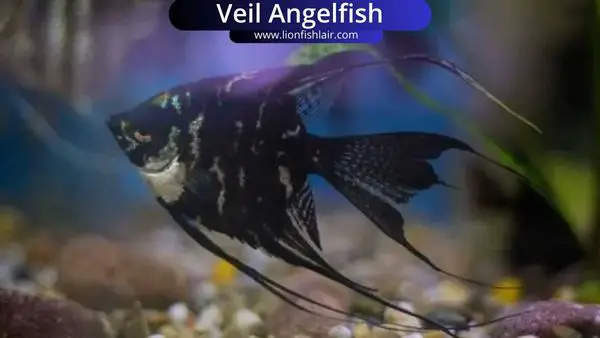
Unfortunately, the length of their fins means that veil angelfish can’t swim as fast as other variants and might be more susceptible to conditions such as fin rot.
10. Altum Angelfish
Finally, you might want to introduce an Altum angelfish into your aquarium if you’re looking for a large, boldly striped centerpiece.
Altum angelfish are mainly silver but can have brown or red stripes. These are robust and tough angelfish that don’t need a huge amount of maintenance, so you won’t need to worry too much about diseases.
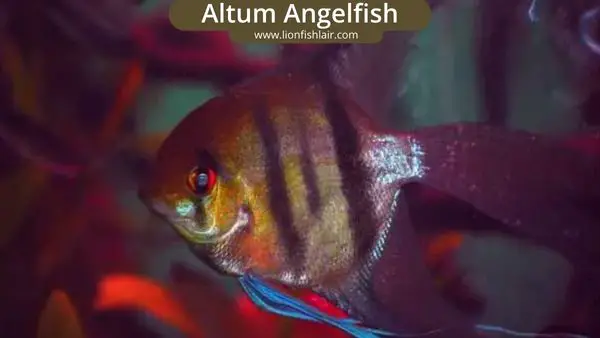
However, Altum angelfish do need some extra maintenance in terms of water temperature and treatment. They need to be in warmer water than most other angelfish, with an optimum water temperature of 92 to 90 degrees Fahrenheit.
Altum angelfish also need softer, more acidic water than their counterparts. The hardness cannot go above 5 pH and the acidity should sit somewhere between 4.8 and 6.2. You probably won’t find an Altum angelfish at your local pet store because they’re quite rare, so you’ll need to find a reputable breeder before you can bring one of these fish home.
Freshwater Angelfish Temperament
You wouldn’t think it from watching these stunning fish float by the glass of an aquarium, but freshwater angelfish can be very highly strung.
Angelfish have dominant personalities compared to many other species of fish, which means that they can display aggressive tendencies. This aggression is particularly prominent between members of the species since the need to establish dominance over other members of the same species is biologically ingrained.
An unsuitable environment is one of the biggest catalysts for dominant and aggressive behavior in freshwater angelfish, which is why it’s so important to put time and effort into curating the optimal environment for your angelfish.
Creating the Perfect Freshwater Angelfish Environment (Tank Setup)
Tank setup is probably the most important aspect of any fishkeeping guide. This is certainly the case with freshwater angelfish too as there are too many things that can go wrong and end up being detrimental to the health of your freshwater angels.
Tank Type and Tank Size
Many people don’t fully realize the importance of a large enough tank when keeping fish. Because fish are such small creatures, it’s easy to mistakenly assume that they don’t need much space.
We recommend designating 30 gallons (113.5 liters) of water per freshwater angelfish in your tank or aquarium. If you take on two angelfish, therefore, the ideal tank size would be 60 gallons (227 liters), although you could get away with 55 gallons (208 liters), which is a more readily available size for aquariums.
It’s also important to note that freshwater angelfish grow taller than they do wide. It’s not unusual for an angelfish to grow up to 10 inches (25.4 cm). This means that they will be better suited to tall tanks than wide, low-profile aquariums.
The graphic below displays the ideal tank size and dimensions for keeping freshwater angelfish:
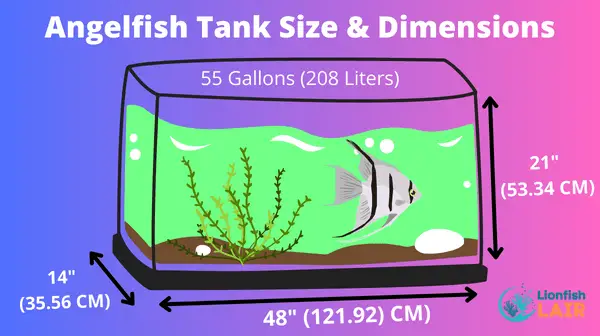
Water Quality
Just because freshwater angelfish don’t need saltwater or specific water treatments to survive doesn’t mean you can get away with dumping your new fish into a tank of water without a second thought.
Before you introduce your angelfish to its new home, you’ll need to test the water to make sure that it is optimal for your fish’s health and quality of life.
First and foremost, it’s crucial to make sure that the temperature of your aquarium’s water is always in the optimal range. Any deviation can cause your fish to become unwell.
A freshwater angelfish aquarium should be kept between 76°F and 84°F (24.4°C - 28.8°C) at all times. It’s also worth getting some water testing strips to monitor the water hardness, pH balance, and ammonia, nitrate, and nitrite content.
For reference, freshwater angelfish thrive in water hardness of between 3 and 10 dH. The pH level should always be between 6.0 and 7.0, which falls between slightly acidic and neutral.
The graphic displayed below showcases the water quality requirements for freshwater angelfish:
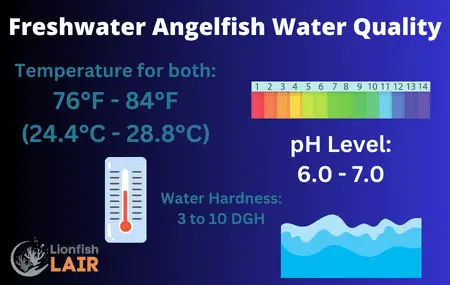
There should be no nitrites or ammonia in the water, and the nitrate content should be kept below 20 ppm. If there is ammonia in the water, you can learn how to remove it or reduce it by following our ammonia removal guide.
Plants and Decorations
Part of creating the perfect fish tank for your freshwater angelfish is making your aquarium as similar to your fish’s natural environment as possible.
Obviously, there are limits to how closely you can recreate a natural freshwater environment in a tank, but one of the best and easiest ways you can do so is by incorporating some freshwater plants.
Not only will the presence of some aquatic plants make your angelfish feel more at home, but it will also provide them with somewhere to take shelter and avoid external movements that could stress them out.
The best freshwater plants to include in your freshwater angelfish’s aquarium are as follows:
- Water stargrass
- Amazon grass
- Melon sword
- Brazilian pennywort
- Amazon sword
All of these plants are native to the Amazon, which is where the majority of freshwater angelfish are originally from.
Freshwater Angelfish Diet
Technically, freshwater angelfish are omnivorous, which means that they can survive and thrive on plant matter as well as meat.
Your freshwater angelfish will be very happy on a varied diet of bloodworms, white worms, brine shrimp, mysis shrimp, algae and plankton.
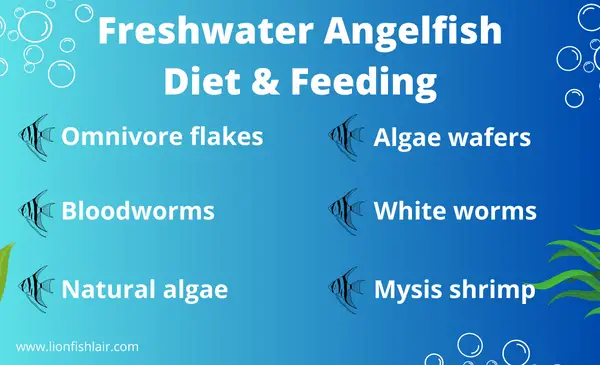
Where possible, supplement this diet with cichlid flakes, cichlid pellets, and blanched vegetables.
Freshwater Angelfish Health Considerations
Generally speaking, freshwater angelfish are quite robust and healthy creatures. Compared to some other species of fish, they are not particularly susceptible to disease.
With that being said, there are some conditions and complications you should be aware of so that you can be prepared in the unlikely event that your angelfish gets sick.
Freshwater Angelfish Parasites
The main health complication that freshwater angelfish can face, even in the controlled environment of an aquarium, is the risk of parasitic infection.
There are two primary species of parasite that freshwater angelfish owners should be aware of.
Hexamita is a protozoan parasite that waits for a fish to ingest it before settling in the intestinal tract or gallbladder. Signs of a Hexamita infection include unexplained weight loss, color changes (specifically a dulling of your fish’s colors), and lethargy.
Another parasite that commonly targets the freshwater angelfish is Nematodes. This parasite is found in egg or larva form in food that has not been properly protected or is of a lower quality.
Nematodes are a type of roundworm, and it’s probably the most dangerous parasite for angelfish. This is because, in addition to causing a loss of energy, Nematodes can cause internal inflammation and bleeding, which may be fatal if left untreated.
To minimize your freshwater angelfish’s risk of contracting a parasitic infection, you should ensure that you are buying only the best quality food and cleaning all food before introducing it to your fish’s aquarium.
Also, remember to clean your tank thoroughly and regularly. Parasitic eggs (larvae) can cling to the walls and surfaces inside the tank, so cleaning on a strict schedule is very important.
If you do notice any symptoms of parasitic infection in your freshwater angelfish, you should first make sure that the infected fish is separated from any other fish or other animals in the aquarium. Parasites are highly contagious, so you want to do what you can to ensure that the infection does not spread.
Once you have isolated your fish, you should turn your attention to possible treatment. You can buy parasite medication for fish from pet stores, but you’ll need to make sure that you get the right type of medication.
This is because parasite medication is typically formulated to target a specific type of parasite and is often designed for consumption only by certain types of fish. If you need assistance, we recommend contacting your vet as a primary port of call or asking a store assistant for help.
Freshwater Angelfish Stress
Because freshwater angelfish are relatively nervous by nature, stress can seriously impact their health.
Stress in fish usually manifests when there is a problem with their environment, such as water that isn’t clean or subpar food. Unhealthy dynamics between tankmates can also cause stress levels to skyrocket.
When an angelfish becomes stress, you may notice it gasping at the surface of the water in the tank, which is a sign of low oxygen and an indication that you should clean and test the tank environment immediately.
A loss of appetite and abnormal movements are also signs of stress and should prompt you to seek advice from your vet.
Just like humans, fish can break out if they become stress, so if you notice white spots or sores on your fish’s body, seek veterinary attention.
Freshwater Angelfish Tank Mates
Freshwater angelfish tank mates are incredibly important to the entire setup of your angelfish tank.
Finding compatible tank mates is never an easy task, however, we have listed up 7 of them.
Before you dive into our short list, we do have a specific page dedicated to beautiful and compatible angelfish tank mates, so, take a look at that for more of a comprehensive guide.
1. Other Angelfish
You can keep freshwater angelfish with other angelfish, although rest assured that your angelfish will be perfectly content on its own.
If you are going to keep several freshwater angelfish together, be aware that displays of dominance and aggression are especially common between males of the species.
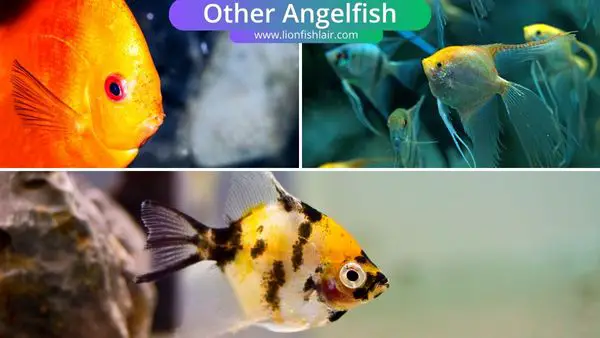
The problem with this is that it’s quite difficult to tell freshwater angelfish males from females. Unlike with some other species of fish, it’s not as simple as simply choosing two females or a female and a male. Additionally, the latter option could also be a problem if you don’t want to end up with lots of baby angelfish).
This is always a gamble you’re going to have to take if you choose to keep two or more angelfish together.
If you want to rule out the potential for mating and keep fighting to a minimum, you might want to consider choosing a different species of fish to keep your freshwater angelfish company.
2. Mollies
The molly, or Poecilia sphenops, is a tough freshwater fish that can adapt easily to a range of environments.
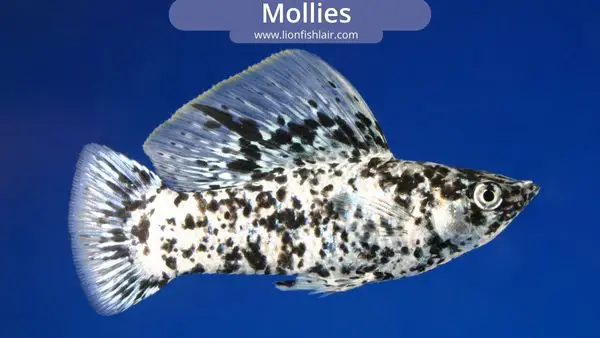
Mollies have docile temperaments, which could make them an easy target for angelfish individually, but these little fish like to live in schools, which should discourage aggressive behavior from the angelfish.
3. Green Swordtails
The green swordtail (Xiphophorus hellerii) is from the same family (Poeciliidae) as the molly.

Unlike the molly, however, the green swordtail is a naturally assertive and dominant fish, so it will be able to hold its own alongside a freshwater angelfish.
4. Tetras
Tetra fish are native to South and Central America as well as Africa. The name is used to refer to several species of chariciform fish. Usually, tetra fish are calm and like to go about their business without bothering anyone.

However, they can become aggressive if confronted, so they won’t be defenseless against your angelfish.
5. Platies
Platy fish are close relatives of the swordtail genus (Xiphophorus), the main difference being that the platy does not have a sword-like fin on its tail.
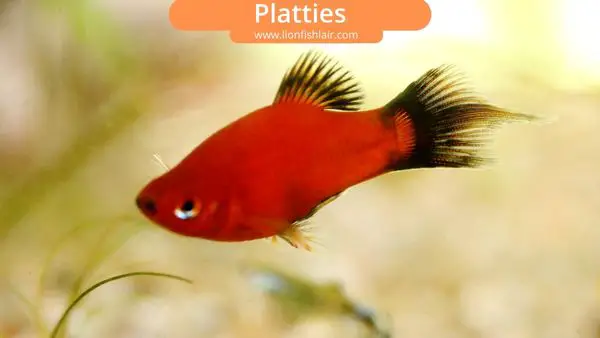
Platies are more peaceful than other swordtails, but they like to live in schools, and aggression has been observed between males, so they should be comfortable in an environment with an angelfish.
6. Bala Sharks
The Bala shark, also known as the Balantiocheilos melanopterus, is a good tank mate for a freshwater angelfish because, while they typically grow to larger sizes, meaning they won’t be a target for the angelfish’s aggression, they are good-tempered. While they can eat small fish as they get bigger, Bala sharks won’t typically prey on angelfish.

7. Corydora Catfish
The Corydora or Cory Catfish can live happily with freshwater angelfish. This is because, in addition to being well-suited to the same kind of environment, Cory Catfish live and move in schools.
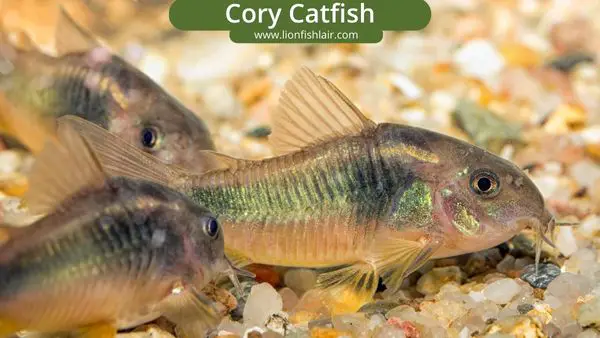
This means that although Corydoras are small and calm by nature, they will have strength in numbers, and the two species of fish should be able to co-exist peacefully.
Final Thoughts
Before you purchase a freshwater angelfish, make sure you think carefully about which variant you want. This is important because different variants have different needs, so you’ll need this information in order to create the ideal environment.
You should allocate 30 gallons of tank space per angelfish and test the temperature, hardness, and chemical content of the water on a regular basis. Before choosing any tank mates for your angelfish, make sure you understand your fish’s temperament and match it with a compatible companion.
Be on the lookout for signs of stress as well as parasitic infection. If your fish displays physical signs of illness or stress behaviors, seek the advice of a professional.
